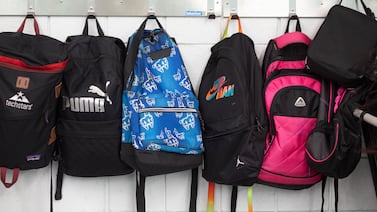New York City principals were caught in the middle of this summer’s political fight over school budget cuts, trying to navigate a financial maze as they prepare to open classrooms next week in the nation’s largest district.
A lawsuit challenging those budget cuts continues to wind through the courts, leaving many principals uncertain whether they’ll get more money this school year. While they welcome the possible influx of cash, not knowing how much they could get or if restrictions will be tied to those dollars also complicated their ability to plan.
“It feels like a lot of things are up in the air,” said Valerie Leak, principal of 75 Morton, a middle school in Manhattan’s Greenwich Village, whose school saw a 35% cut in funds, totaling nearly $2 million, for hiring and planning. “It’s been quite a rollercoaster.”
Despite protests from educators and advocates, elected officials in June approved cuts to school budgets based on declining enrollment projections. Roughly three-quarters of the city’s schools saw their budgets shrink from the previous year, according to Comptroller Brad Lander, who calculated $372 million in cuts across all schools.
Then in July, two parents and two teachers filed a lawsuit against the city challenging the approval process for the cuts. A Manhattan judge ruled in their favor, and ordered Mayor Eric Adams and the City Council to redo the education department budget. In the meantime, the judge called for the city to fund schools at last fiscal year’s levels — roughly $1 billion more than planned for this year.
In yet another twist, an appeals court judge put that on hold until the court reviews the case on Sept. 29, which is three weeks after school starts.
Still, while the budget cuts have been tough on school communities, an “overwhelming majority” of principals are ready to open their buildings, said Mark Cannizzaro, the head of the principals union. For those who are not ready, the education department is providing “very prompt” help once the union flags it, he said.
“In the last two years with COVID and the pandemic and the craziness happening there, people literally were not ready to open their buildings,” Cannizzaro said. “This year I am hearing, although there are some challenges, the overwhelming majority of people are ready to open their buildings.”
A dizzying problem
On the school level, the cuts and legal battle have been dizzying for principals who have been trying to plan yet another academic year.
At 75 Morton, Leak is expecting 500 students, so she was “shocked” when she learned that the education department projected 381 students to enroll at her school in the fall. With more than a third of her budget slashed, she had to excess 13 staffers, meaning they would no longer work for or get paid by her school but could look for work elsewhere in the system while being paid by the city.
She let go of just half of those staffers while others left the school on their own accord.
Meanwhile, she appealed the education department’s budget based on its enrollment projections, checking in for nearly two months to see if it had been granted. Finally, she was able to secure funding in mid-August to hire four teachers. But the drawn-out process delayed her ability to post the job openings and made it harder to find candidates.
City officials said the ongoing lawsuit temporarily held up the appeals process, but the process was expedited in August.
“I wouldn’t have been able to start with a full staff if the appeal hadn’t gone through,” she said.
If the lawsuit results in more money, she also hopes to rehire a social worker and a counselor.
Parents are worried about losing those positions because they “want a lot of support” for their children, which Leak also wants, she said.
“It makes hiring tricky because you don’t wanna hire someone and say, ‘Oh, sorry, we no longer have the money for you,’” Leak said.
Enrollment loss snowball effect
With about 20% less funding at P.S. 503 in Brooklyn’s Sunset Park, the principal, Nina Demos, cut three classes this fall and increased class sizes in some grades. Some extracurricular and enrichment activities also were in limbo.
Here were some of the complicated calculations Demos faced: In April, she made plans to hire a bilingual special education teacher and planned to cover that salary with separate funds from the education department. That funding, however, didn’t hit her budget until Tuesday, so she had to front the salary from COVID stimulus funds. (Originally reserved for “academic recovery” activities, such as tutoring, city officials are now allowing schools to use that money for teacher salaries.)
That left hardly any money in her budget for overtime costs used to pay teachers who oversee things like clubs or tutoring while she waited for the other funds to come through, she said.
Without the money in hand, Demos didn’t feel comfortable planning after-school programs or clubs, or even telling families about the possible options.
One parent left the school because of the uncertainty, enrolling in a nearby charter school, she said. If she had some more money on hand, she could have committed to run programs through at least the fall, she said.
“We’re in this situation because of register loss, but it further exacerbates register loss,” Demos said.
Demos now expects to use her newly freed up COVID relief funds for a limited number of clubs and other after-school programming and a Saturday academy.
Flexible stimulus funds are ‘welcome change’
One Queens principal, who asked not to be named, said the ability to use relief funding for teacher salaries was “a welcome change.” His school lost very little funding, but with dozens more students enrolled than projected, he wants to hire new staff.
He hopes that the relief funding can be used as a stopgap measure until this winter, when he’s banking on getting more money from the city because the school is enrolling more students than projected — known as the mid-year adjustment. When schools get those funds in the middle of the year, it’s usually too late to pay for the teachers.
One Manhattan elementary school principal may use all of her academic recovery dollars on a teacher instead of paying for extra services or tutoring, as she did last year. Her part-time English as a new language teacher retired and must be replaced, said the principal, who spoke on condition of anonymity.
An education department budget staffer told her she had to use her academic recovery funds after she appealed for more funding.
A week out from the first day of school, the principal has been unable to find a replacement — and she isn’t sure it’s enough money to make a hire.
The principal saw her budget cut by about 25% and was forced to excess one of her few teachers of color because they were one of the newer staffers. That felt painful and at odds with the city’s rhetoric on hiring a more “diverse staff,” she said. Three-quarters of her teachers are white, even though more than 85% of her students are of color.
The principal also may not have enough funding to maintain a service they offered last year at the school, where 75% of students are living in poverty: paying teachers overtime to supervise children who need before-school care.
“I would have to limit the number of children we could have coming early,” the principal said. “That’s one thing we’re thinking a lot about.”
Alex Zimmerman contributed
Reema Amin is a reporter covering New York City schools with a focus on state policy and English language learners. Contact Reema at ramin@chalkbeat.org.








